Highlights of the Amsterdam Pipe Museum
Author:
Don Duco
Original Title:
Hoogtepunten uit het Amsterdam Pipe Museum
Publication Year:
2020
Publisher:
Amsterdam Pipe Museum (Stichting Pijpenkabinet)
An unprecedented lion's head

Designing figural porcelain pipes was not always easy for the earliest porcelain makers. This is understandable because china clay is quite difficult as a material to work with. Even when the porcelain mass is plastic enough for modeling, the adventure is still challenging. In addition, because porcelain pipes are of great luxury, the consumer expects them to be suitably mounted with a lid and cuff rim, and attaching metal to the porcelain is another hurdle. The tobacco pipe discussed here is a good example of the porcelain maker's struggle to arrive at a usable and original product.
This remarkable figural tobacco pipe represents a lion, to be precise a half-lion because the head and front legs are depicted in the pipe bowl, the body of the animal bends in the stem and is truncated there. The pipe bowl itself falls into two parts. The base shows the lion with the front legs raised in front of it, the top half of the lion's head acts as the lid of the pipe. The modeling is unexpected and attractive, but also somewhat rigid and therefore rather artificial. For example, notice the mane that is modeled as large locks, not really naturalistic.
Painting of porcelain pipes was common from the very beginning. It provided a bright result that was not affected by the discoloration of the surface, as with the clay pipe. Porcelain is impenetrable and retains its appearance so that the painting always remains fresh. In this case semi-natural colors have been chosen that give the animal its realism, although the color of the skin is a bit on the yellow side in our view, some more brown might have been appropriate. The red corners of the eyes are subtle, emphasizing the lion's bloodthirsty character. The corners of the eyes were applied at the same time as the red in the mouth, so the painter only had to lift the brush once.
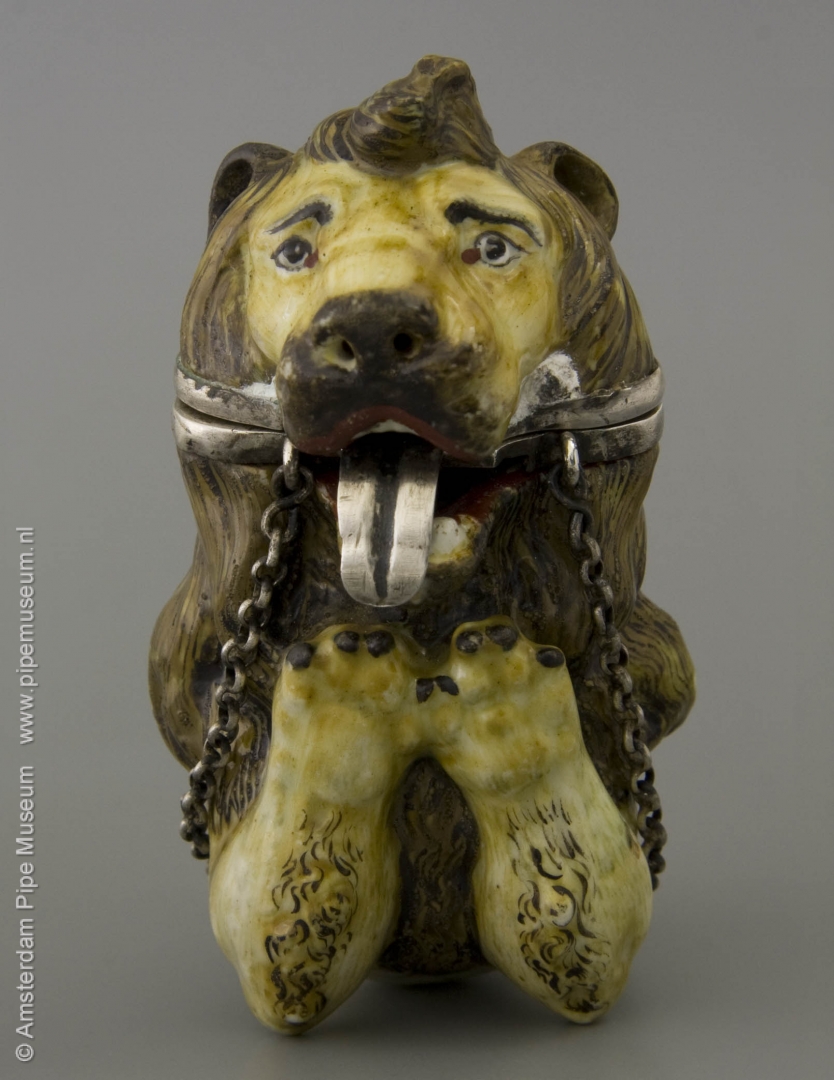
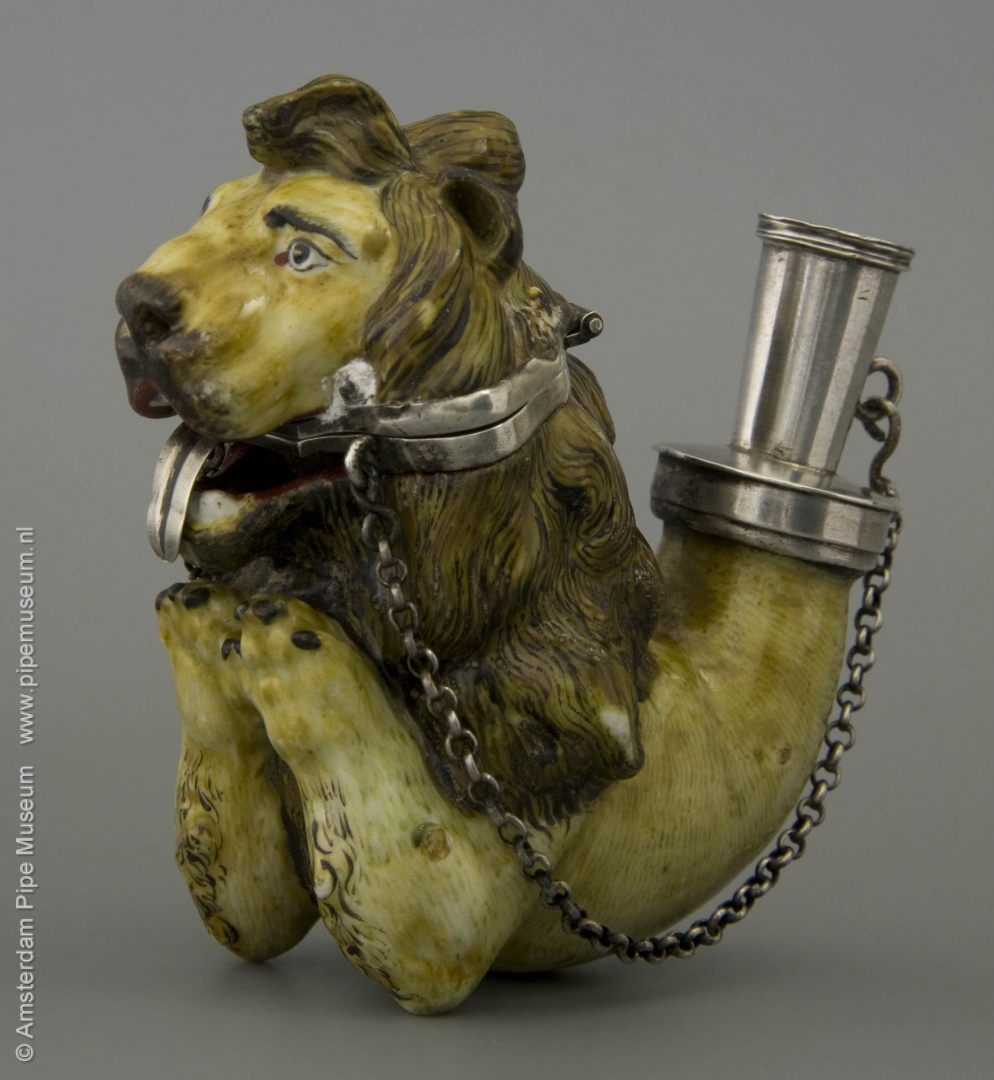
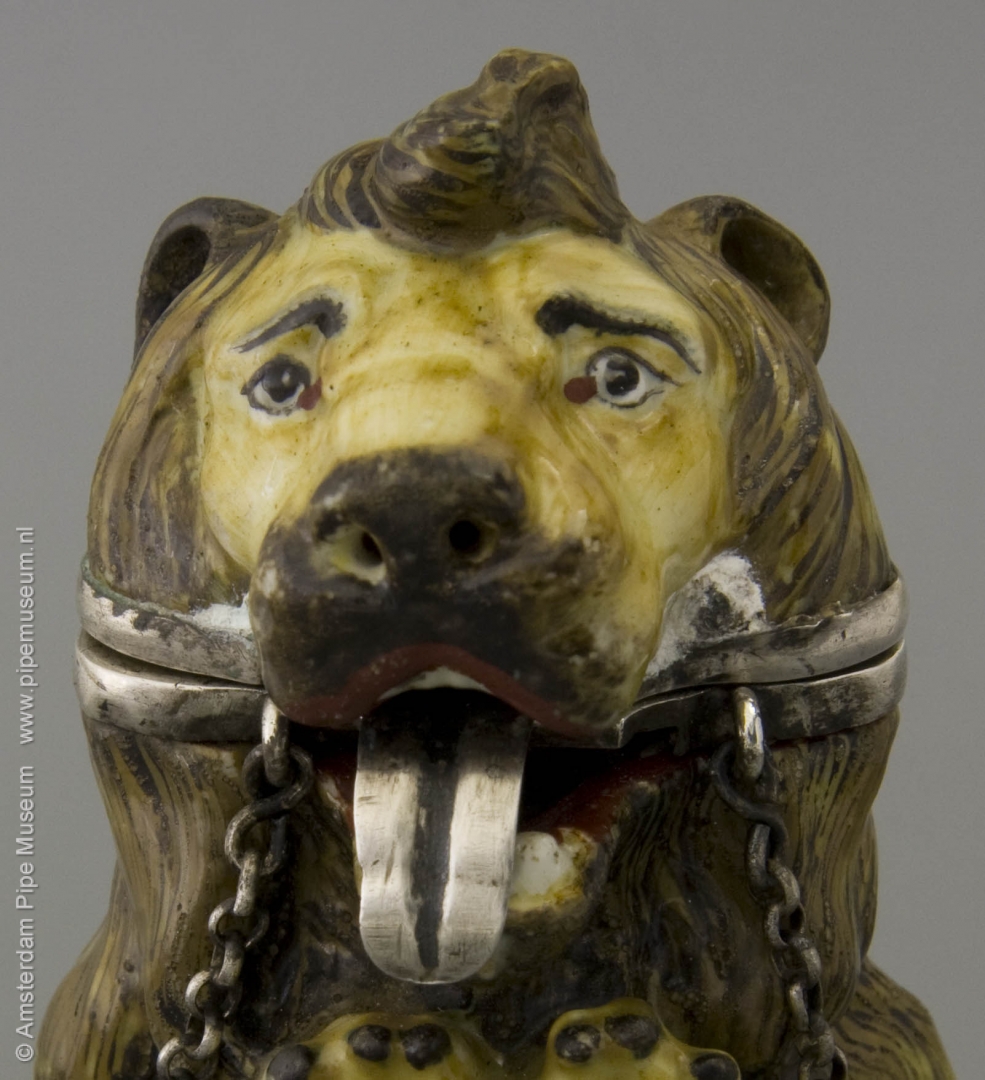
The struggle in the production of this pipe especially comes into view when the silver mounting had to be made. The lid ring that was devised for this pipe bowl is very inventive but extremely laborious. Since the lid cuts the lion's head horizontally, this ring follows the cross-section of the head with all its whimsical locks and other relief elements. The hinge, also to be placed in that same zone, requires a straight part. Very original is the clamping spring to keep the lid closed, which is designed like the lion's tongue. The bowl interior is also made of silver, the maker apparently did not see any benefit in a porcelain inner bowl. At the bowl opening we see two eyes for retaining chains leading to the cuff. Decorating luxury objects with single or double silver chains was quite common during that period and would remain common for pipes well into the nineteenth century. The cuff mounting is also made of silver and shows a long funnel-shaped stem holder also with a locking eye. This long sleeve is in keeping with the heavy weight of the pipe bowl, which requires a sturdy stem with a solid start.
According to the Meissen archives, such a pipe was designed by Johann Joachim Kändler in 1738. This early dating indicates that the factory still had many design details to overcome, a challenge even for a master designer like Kändler. A tobacco pipe has tricky requirements: in addition to being easy to handle, it must be heat-resistant, while the porcelain body and glaze must also be able to undergo an attack from moisture. All in all, we see that Kändler has overcome countless obstacles with this creation, but has not yet arrived at a perfect product. This is mainly reflected in the relatively heavy design. For that reason, other experts argue that this pipe is not so much an experiment, but a product from a later time, when the technique was already mastered. For example, it could have been made in a porcelain factory of lesser capacity, such as that of Fulda, where, according to the archives, a pipe with a lion's head is mentioned in 1786. No one has ever seen it. For the time being we assume that our copy was made by Kändler in Meissen.
Amsterdam Pipe Museum APM 17.157
Pipe bowl with three male heads and a monster

A unique design with an unexpected detail, you could call this tobacco pipe. Around the almost cylindrical shaped pipe bowl the designer very cleverly modelled three human faces that each share an eye with their neighbour. The three male portraits obtained their own facial expression: angry, with a smiling mouth or bared teeth. But those who look better will notice a fourth head, namely that of a monster and ironically the smoker himself has a view on that. With an opened mouth with sharp teeth, it bites into the stem and its snout is hidden in the stem angle. Here, too, the animal lends its eyes to his neighbours, which makes them lie quite far apart, very appropriate for a monster head. All in all it is a special pipe bowl with a beautiful, yet rather creepy ornament all around.
This unexpected design was made by Johann Gottlieb Ehder, modeller at the famous Königlichen Sächsischen Porzellan Manufaktur in the city of Meissen. Thanks to the extensive factory archives we know that this pipe bowl was created in June 1743. The famous master-modeller Johann Joachim Kändler, master of Ehder, registered the design in the shape book. Incidentally, that happened only after he had made some refinements, although we do not know which one.
A plaster mould was made from the design and then the pipe was taken into production. After the modelling and finishing of the porcelain paste, the first baking process followed. Then the object is glazed. In the painting department, the porcelain object was carefully polychromed and the three faces each received their own identity. To achieve a good distinction, the painter added a moustache or a goatee. The production figures of this article is not known but at Meissen this usually was no more than a handful of copies, since the customer base for such luxury items was extremely limited.
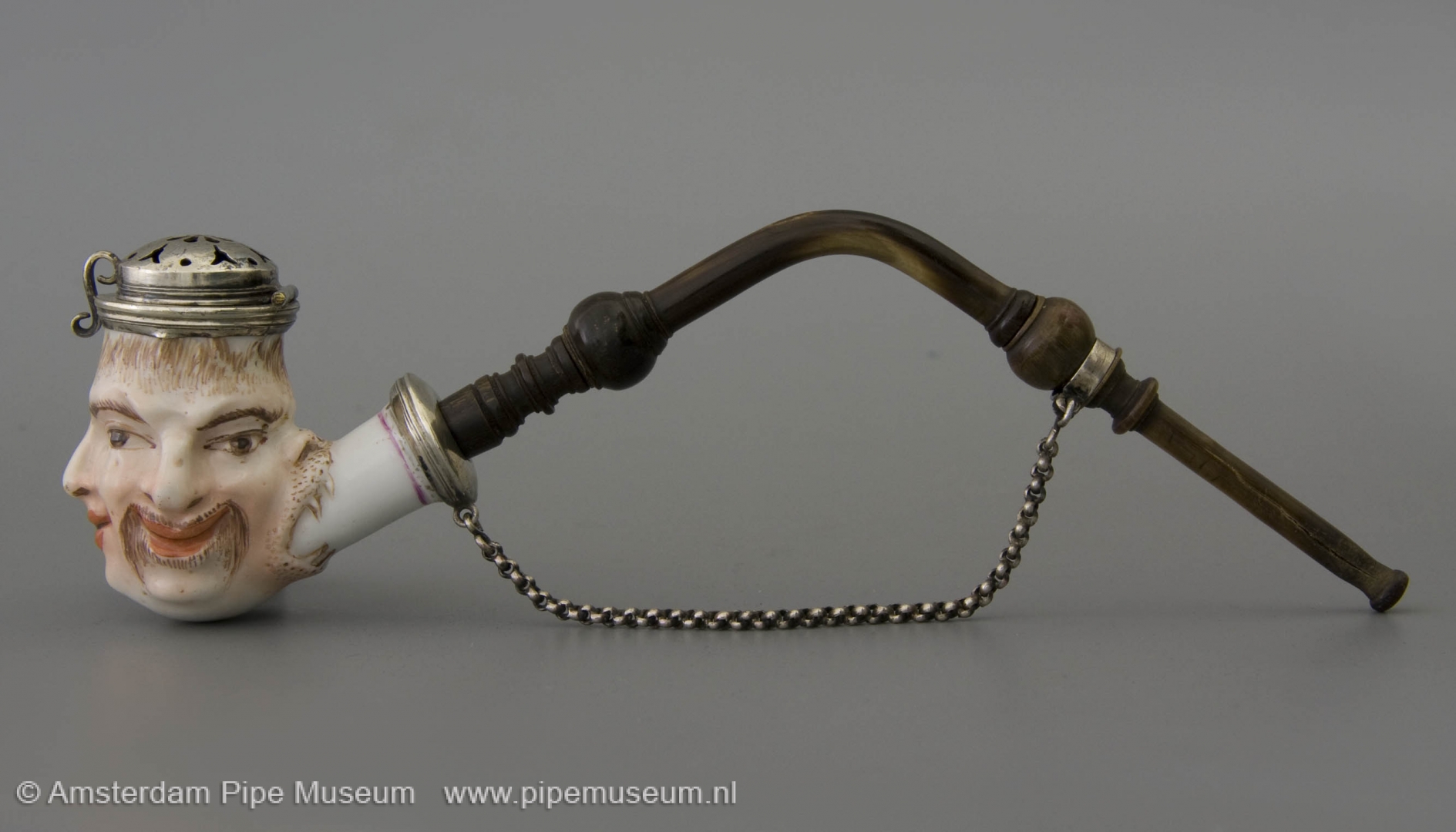
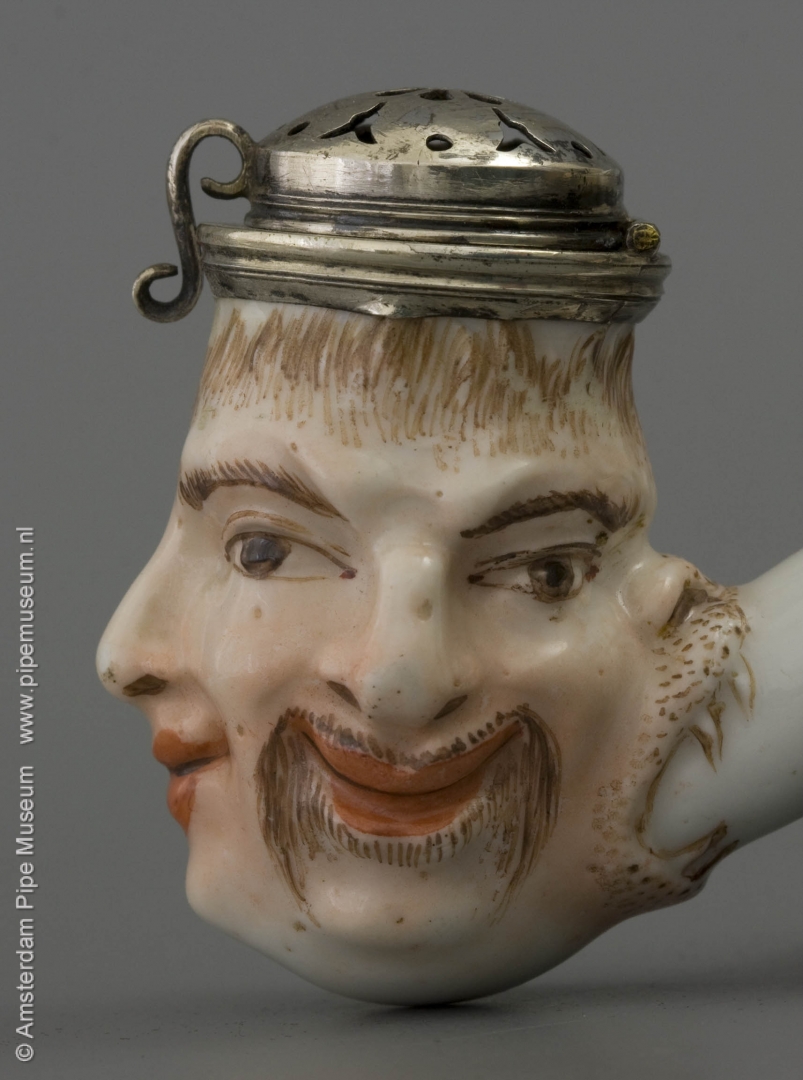
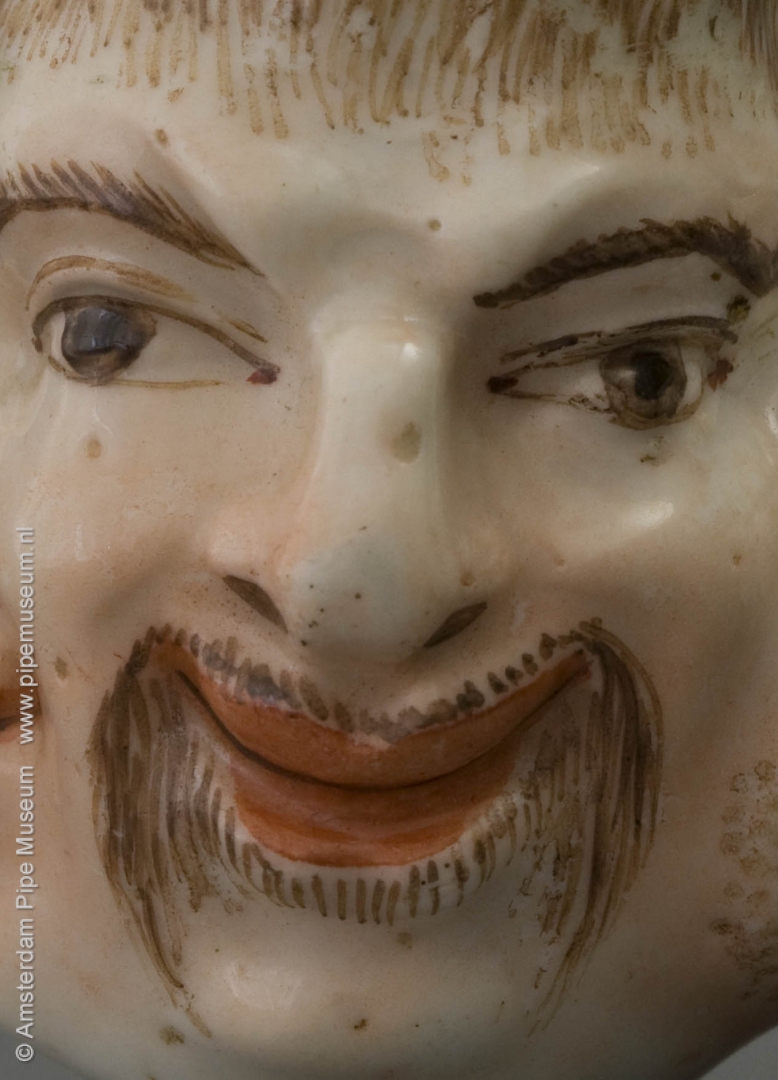
Everything shows that this tobacco pipe was a valuable item in its time. This is demonstrated by the beautiful porcelain, the careful painting but also the fine mounting. The porcelain pipe bowl is in fact provided with a silver framing consisting of an open sawn domed lid and a silver stub ring. With the aid of an equally silver retaining chain, the stem end is attached to a separate buffalo horn stem. This stem consists of two parts that screw together with a fine screw thread. The result is a usable pipe stem with a strong kink.
After more than 250 years the pipe still has its original gift box, a cassette that is a piece of art in itself. It is a rectangular box with bevelled corners and a slightly domed lid. The outside is covered with green shagreen or stingray leather, the inside is lined with red velvet and pink silk. The parts fit in three compartments: the pipe bowl and stem in two parts. It should be clear that such a luxury box with precious content was at the time almost counted to the category of jewellery.
In the 1740s the figural tobacco pipe was on the rise, not only in Meissen, but also at other porcelain factories. Despite the large variety of shapes, it always remained precious objects, as a gift for princes and the high nobility and certainly not for the ordinary smoker. Such luxury objects were usually handled carefully, initially by the smoker who used the pipe for a year or so. Most copies, however, were quickly promoted to a showcase because of the art value. That also happened with this pipe. Of the limited number of pipes produced, only a few have been preserved. Of this design a second is known, which is located in the museum of the city of Regensburg. That copy is made in the same print mould but has a different paint scheme.
Thanks to the powerful modelling, the detailed painting and the luxurious way of mounting and packing, this tobacco pipe is far above the contemporary smoking pipe. The art and rarity value makes this article a desirable object. That is why it nowadays only happens sporadically that such an item appears on the market. As far as this model is concerned, no third copy has yet been found, but perhaps this web page is the incentive!
Literature: Don Duco, Pijpenkop met drie mannenhoofen en een monsterkop (Pipe bowl with three men's faces and a monster head), Amsterdam, 2005.
Amsterdam Pipe Museum APM 15.078
Subtle lacework in porcelain
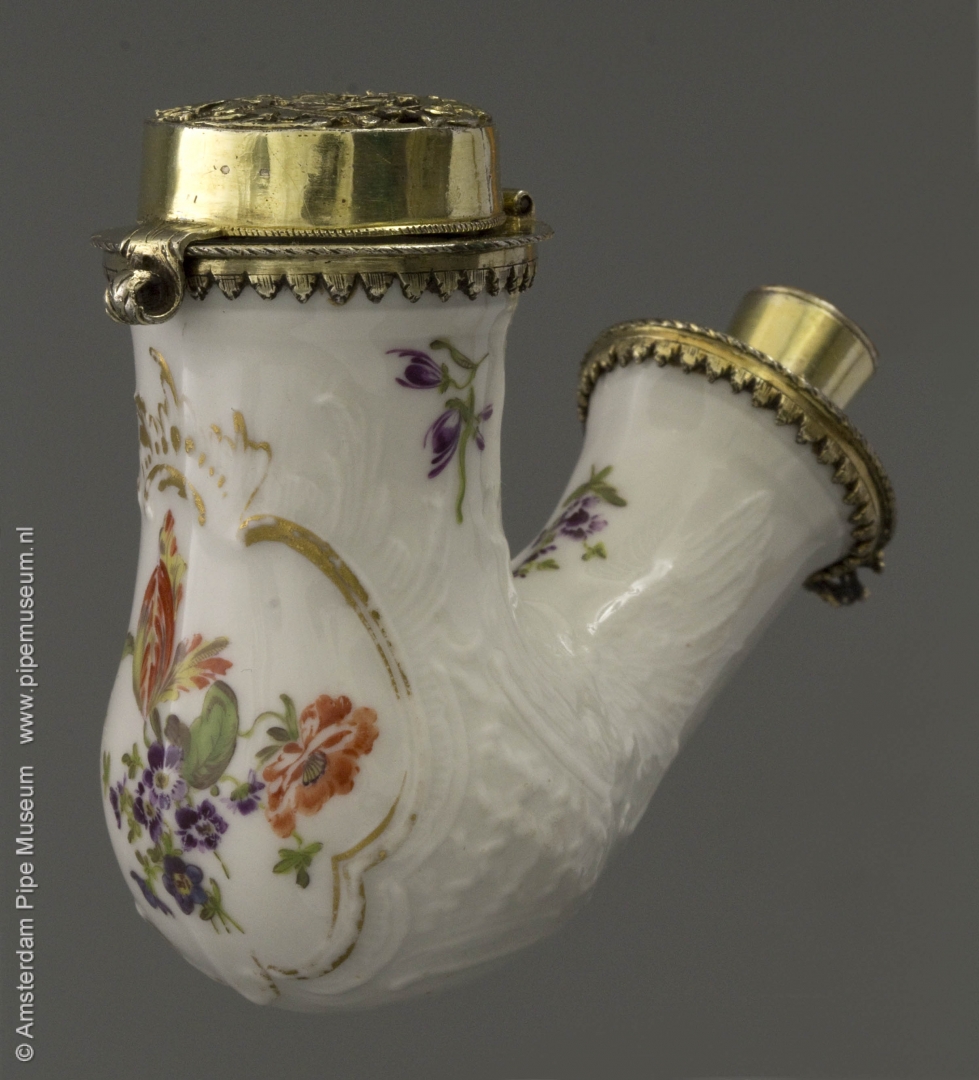
In the first period of the porcelain pipe bowl, the stub stemmed bowl à la Turque is popular. It is a pipe shape that is halfway between an Ottoman earthenware pipe and the earliest meerschaum pipe bowls brought in from Turkey. We are then talking about the mid-18th century. The shape of the tobacco pipe discussed here most closely resembles the kalmash, a pipe bowl with a bulging round bottom and a slightly flared bowl opening. This kind of pipe shapes are mainly made in meerschaum, in all kinds of proportions. The example here is a bit higher than average, but each shape has its own elegance.
Needless to say that the kalmash was also copied in porcelain. At the famous Königlichen Sächsischen Porzellan-Manufaktur in Meissen, such pipe shapes are sometimes provided with an extremely subtle relief work in the white China clay. We see this in optima forma with the pipe bowl shown here. The outside is provided with a fine-drawn pattern, which gives the porcelain surface a delicate relief effect. This could simply be made thanks to the plaster mold in which a dainty decoration could well be applied. This pipe has a large cartouche at the front, framed by a rococo frame with thin asymmetrical waves. The other parts of the bowl do have the same kind of relief decoration, subtly flattened by the transparent glaze. Finely worked out, at both sides of the pipe bowl we see a field with a weaving pattern, followed by a peacock with spread wings.
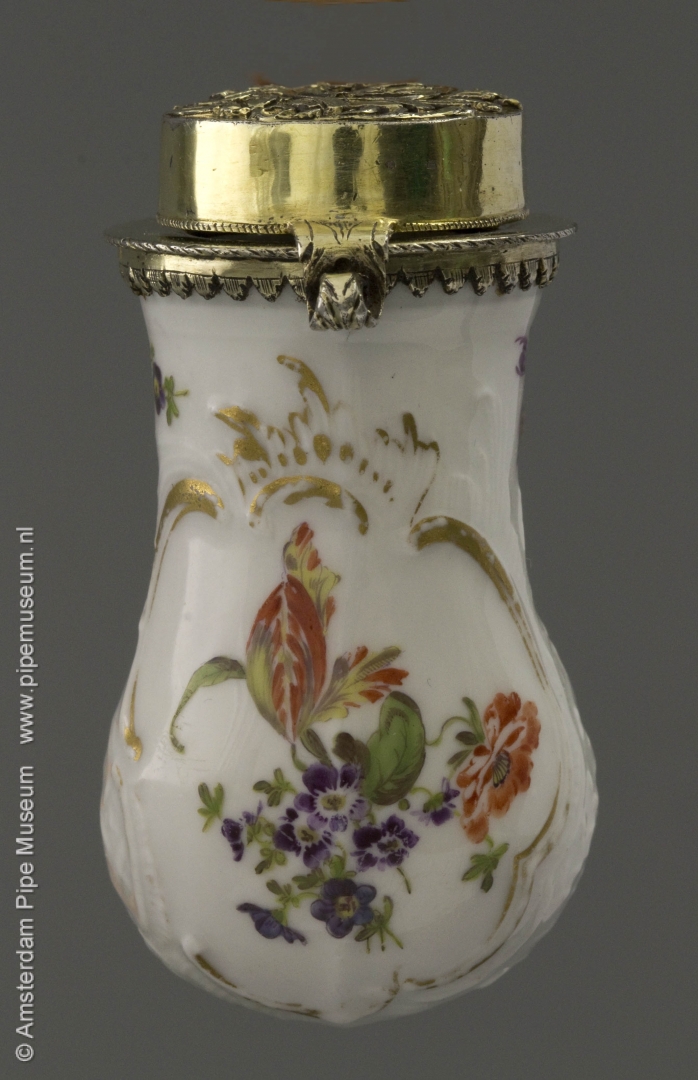
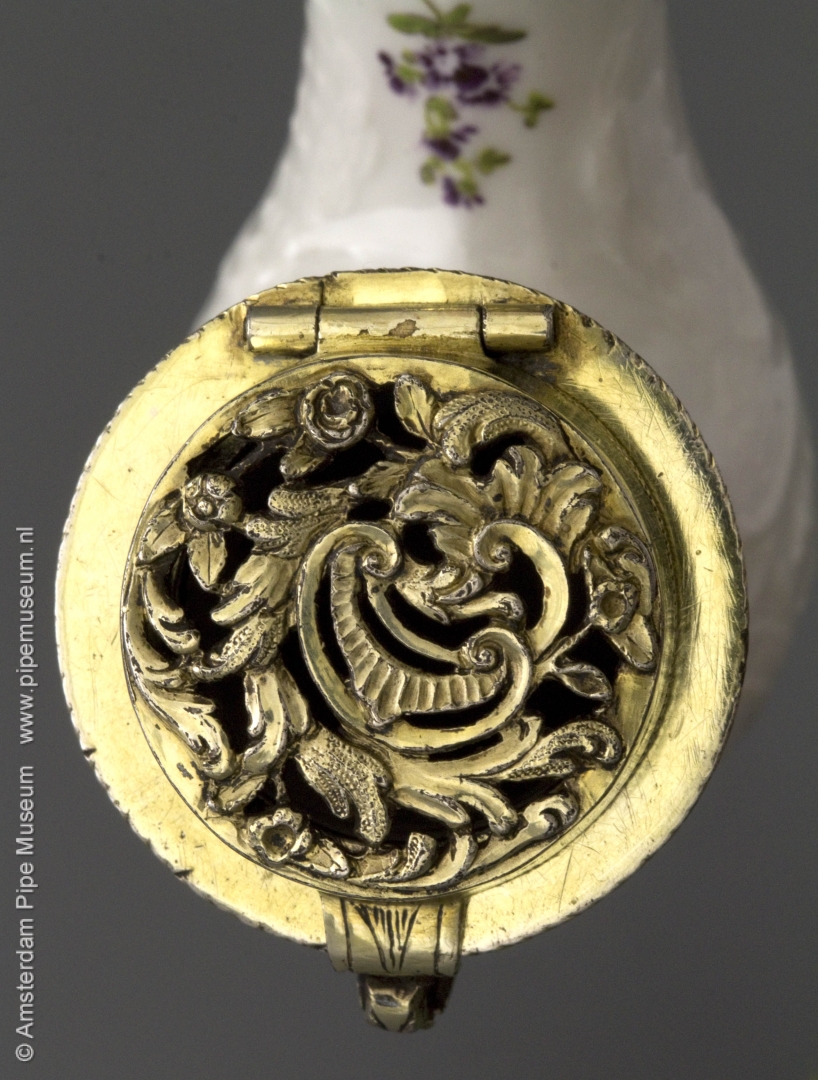
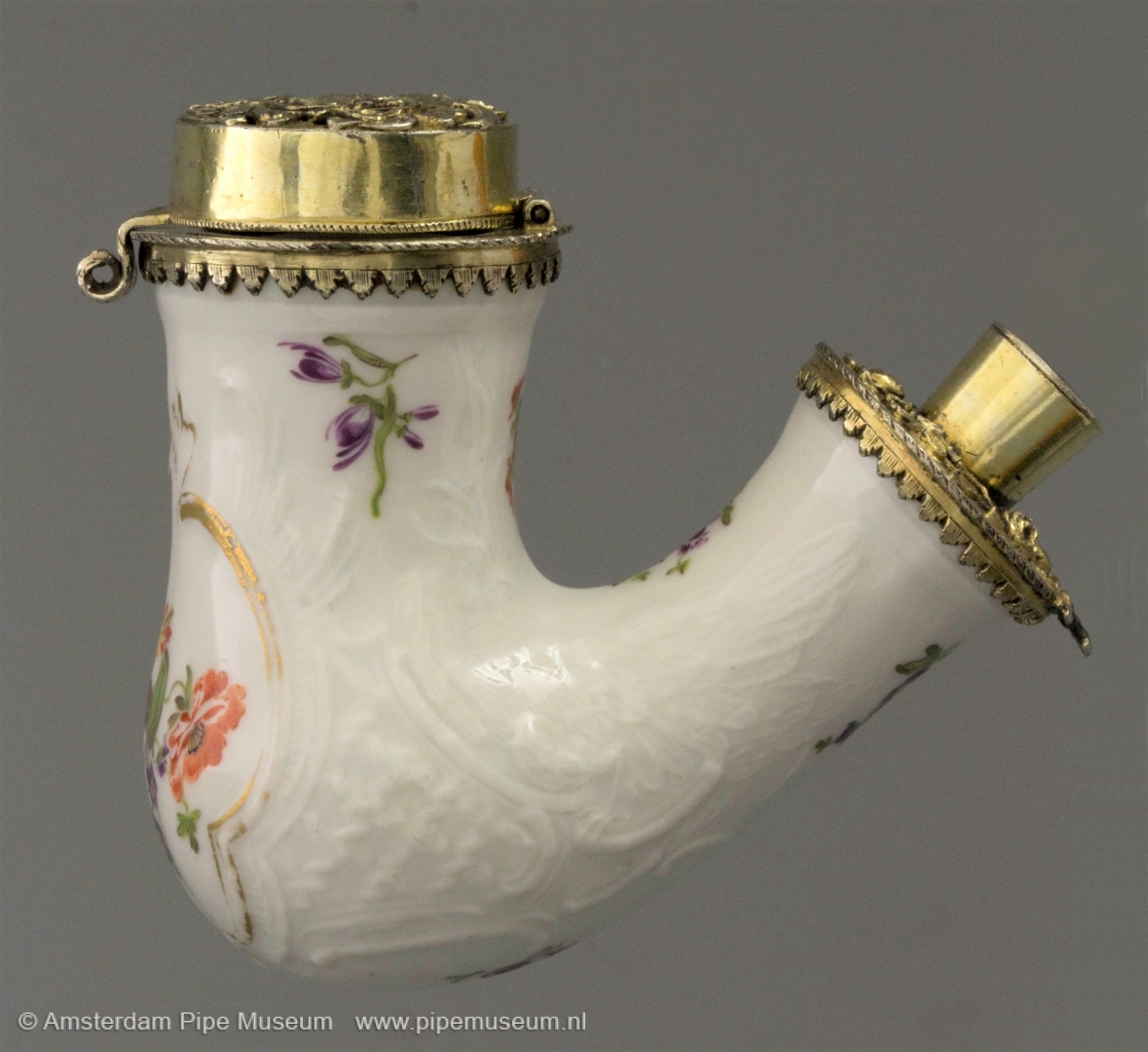
After the pipe has been provided with a transparent glaze, the second firing, the pipe is finished in a multi-color palette. The relief work serves as a frame. The painting is done here with a steady hand in a touchy style, with a bouquet of forget-me-nots and other flowers in the cartouche. Furthermore, only some simple flowers are sprinkled over the surface. This painting is then baked in petit feu, small fire because the colors do not tolerate high temperatures. Accentuating the frame with a gold leaf lining is the last treatment, now the umpteenth handling! It is a method that is also used for coffee and dinner ware. The fact that a simple and very modest flower decoration was chosen for this pipe bowl says something about both the style of the pipe and the selling price. A fully filled cartouche would drastically increase the price of the object, but also give it a more colorful look. It is just what one desires.
Another exclusive element is the mounting with a gold-plated silver lid and stem holder. Two features of this montage indicate an early date. The lid itself is kept flat and the stem plate has an eye for the retaining cord or chain that is not soldered on but cut from the same plate. The top of the hinged openwork cap is modeled with two c-volutes surrounded by rich foliage. This is not sawn, but cast in relief. The cuff plate shows a wreath of roses around the stem holder with a bird at the base. It is also cast in relief, although it is based on a different design than the one of the lid. The gilding of both metal parts fits beautifully with the gold tufts around the cartouche.
Be aware that even the original wooden stem has been preserved. From bottom to top a snake is winding around the stem with the head at the pipe bowl and the tail tip at the mouthpiece. The regularity of the swinging snake body gives the stem a beautifully twisted appearance, the eyes filled with glass paste make the animal realistic. The kink in the buffalo horn mouthpiece ensures that the mouthpiece lies horizontally. All in all, it has become a beautiful smoking instrument, luxurious but also discretly restrained. A very chic and fashionable pipe for a discerning smoker who does not want any less, but has no desire to be noticed.
Amsterdam Pipe Museum APM 22.650
Polish character head in pouch
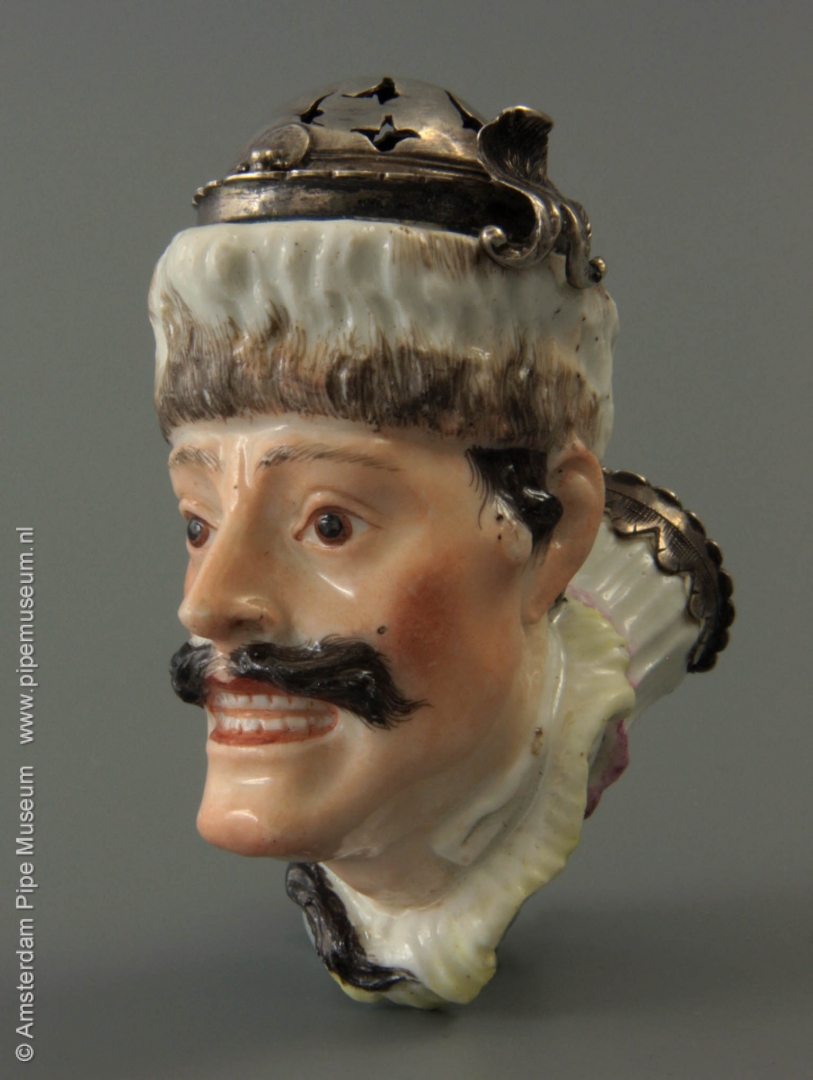
As a leading factory, the Royal Saxon porcelain factory in Meissen rapidly developed a series of luxury tobacco pipes. They were made as an alternative to an array of chic items, such as snuff boxes, walking stick knobs and figurines. Pipes that served in the highest circles to surprise and impress friends and acquaintances. The subjects sometimes related to the current events of the day, gallant and entertaining images are also featured. This portrait pipe is a fine example of such a luxury item.
The bowl shows the head of a Polish man with a bushy mustache, square pointed chin and cylindrical fur cap, the neck enclosed by a wavy collar with distinctive rococo features. The stem of the pipe most closely resembles two pleated cuffs pushed together. We know the name of the proposed one thanks to a price list from 1765 in which this pipe bowl is mentioned as Le Polonais, including the price of 1 Taler 4 Groschen each. That price does not seem high, but when we consider that at the time a clay pipe was sold for a few Groschen, we have to conclude that the porcelain pipe bowls were only for the very few.
As usual, this pipe bowl is painted in natural colors. That painting betrays the moment of manufacture. The designs often remained in production for longer time, the paintwork was only done when the time of sale was approaching. With every new painter, the aura of the portrait changed. Naturally, this was to the advantage of the variety. The subtle shades in the pink skin, the ruddy cheeks and the fine tufts of pink along the stem, we recognize the typical eighteenth-century handwork.
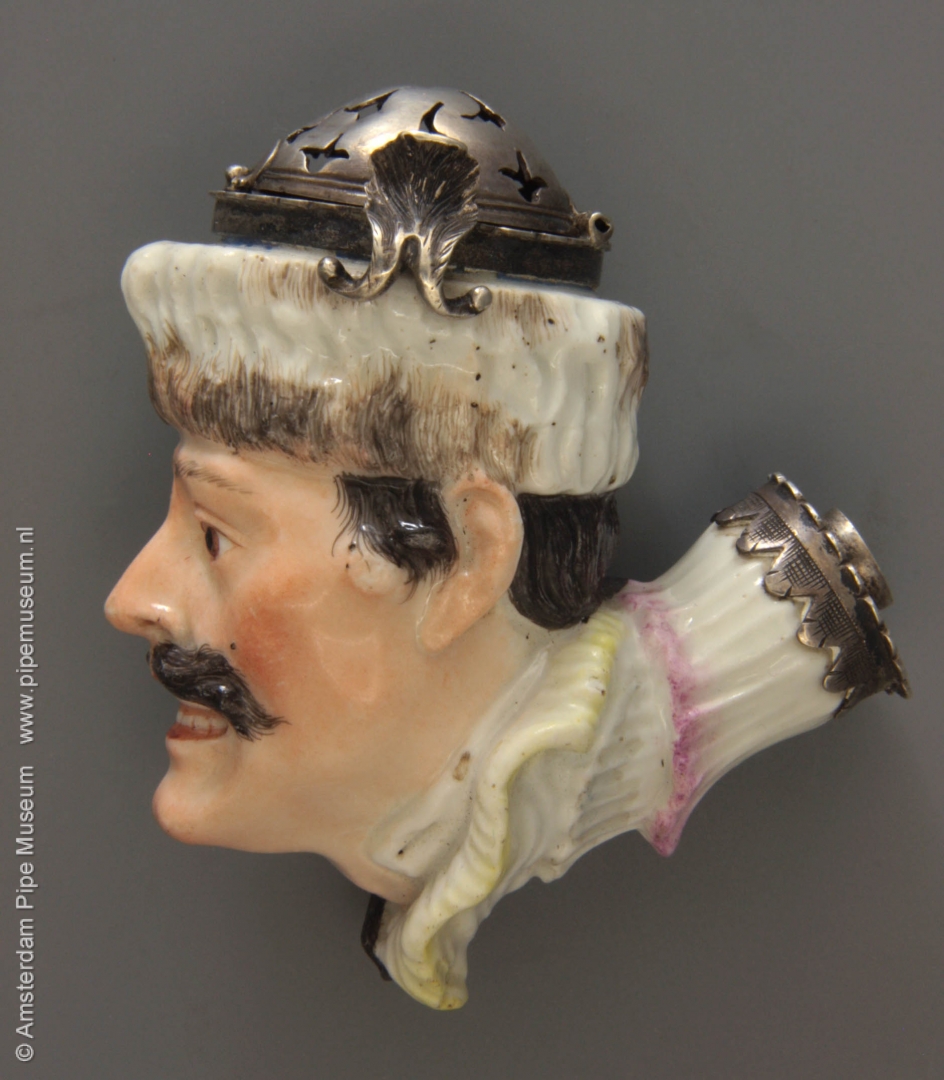
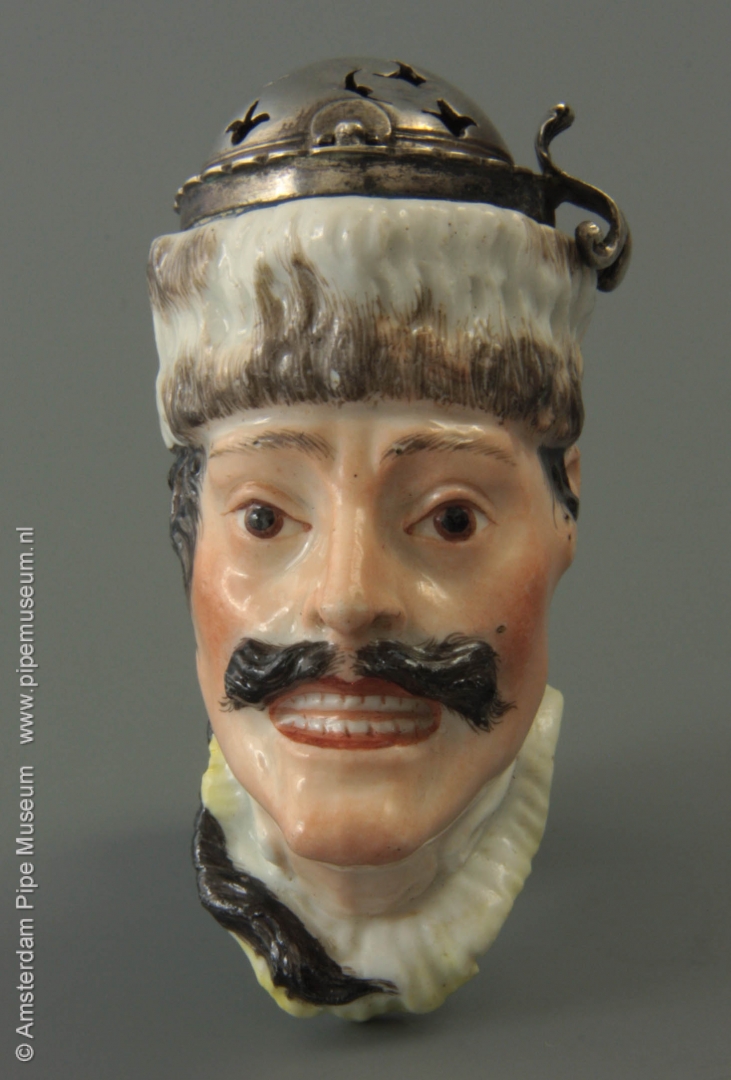
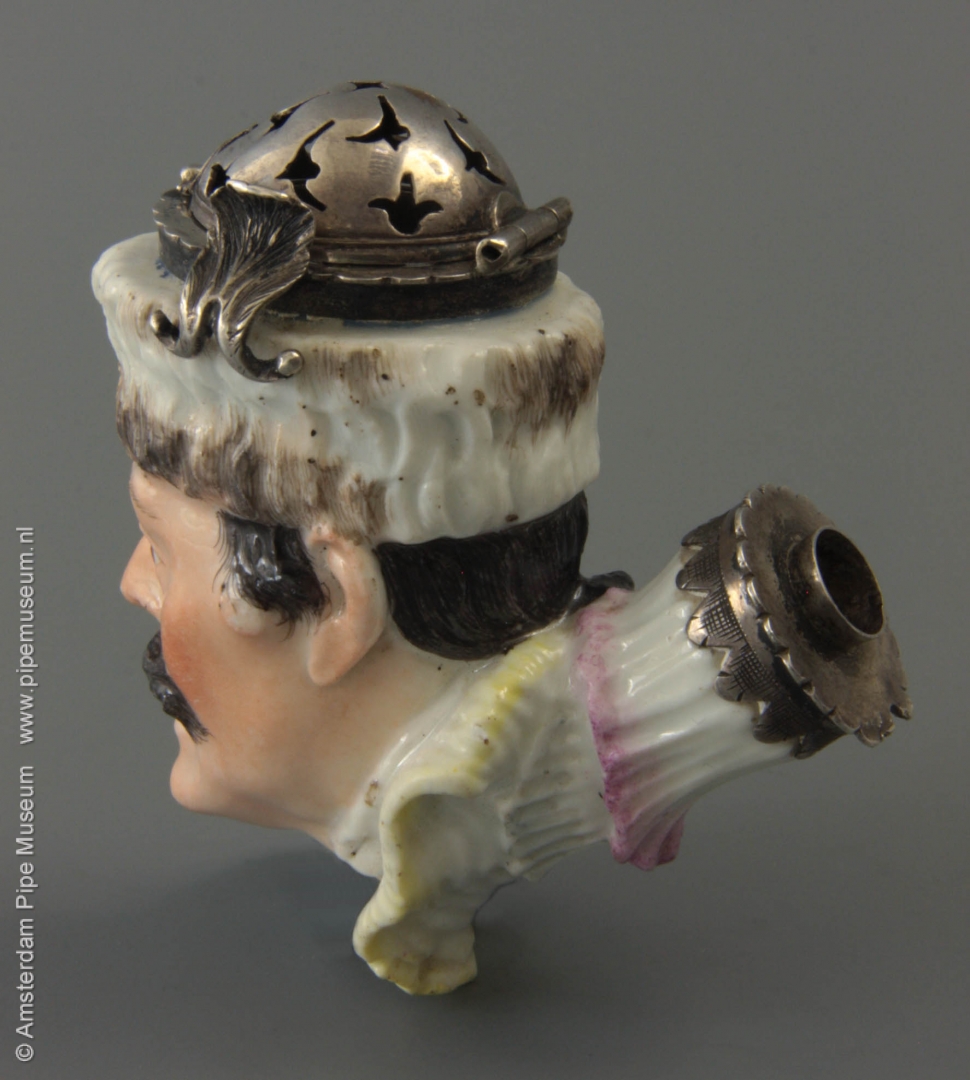
Complete as it is, this pipe bowl still has its original mounting of a silver hinged lid with a perforated dome shape; a silver feather that hangs over the hat is very playfully soldered to the bowl opening. The cuff plate, connecting to the pipe with a lobed and engraved border, ends in a plate with a wavy contour, in which a short stem holder with a thinner stem diameter.
Exceptionally, the pipe was preserved in its original wooden gift box. The cassette shows brown leather on the outside, on the lid we see a piping along the edge and blooming flowers made with embossing stamps and gold leaf. The inside with cork interior, shows one compartment for the pipe bowl and aditionnaly six slots for the parts of the stem, all lined with green velvet. The twisted ivory stem parts can be screwed together, in such a way that the half spheres at the ends become complete spheres; the stem attachment and mouthpiece are unfortunately missing. The cassette emphasizes the regal appearance of the object.
Despite great luxury, this is not an extremely rare pipe. This proven by the fact that various museums in the world own a copy of this pipe, as mentioned, all painted slightly differently. We mention Dortmund, New York, Grasse and Amsterdam.
Amsterdam Pipe Museum APM 19.818
Smokers from different cultures
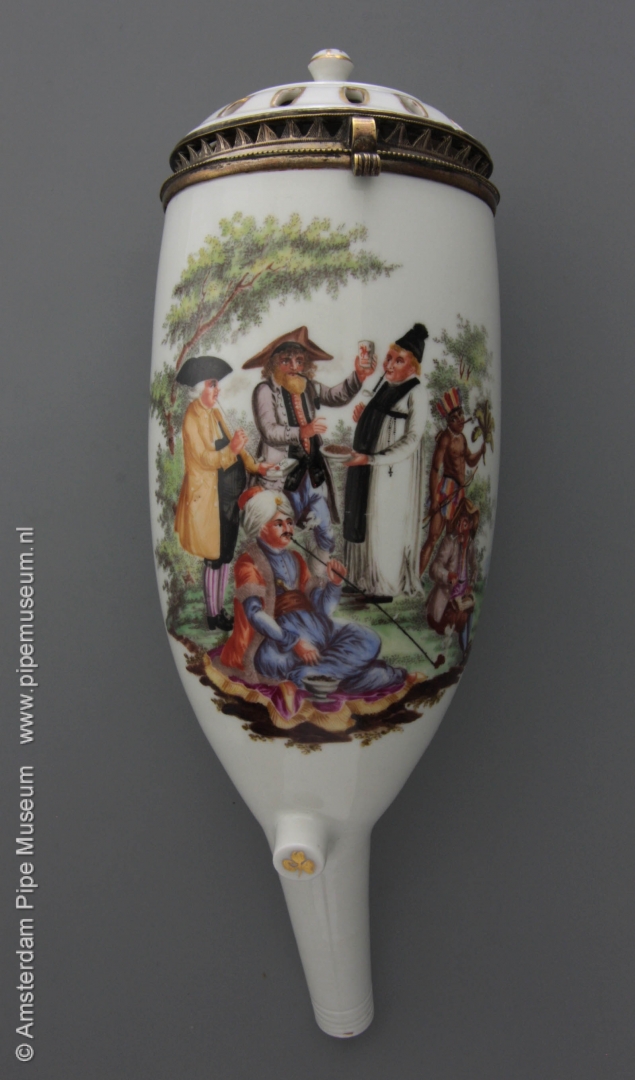
This tobacco pipe is special for two reasons. Firstly, it is not a standard size, but it is a very large model with a bowl height of over 23 centimeters, while 10 to 11 centimeters is normal. It is therefore a very large stummel bowl with a somewhat excessive bulging, knob heel and a short straight insertion stem. The chubby nature of the pipe bowl fits well with its giant size. In addition, the pipe carries an appropriate image with pipe smoking as its theme.
The pipe bowl is hand-painted on the front with a convivial gathering of pipe smokers from all parts of the world. Four main characters of different backgrounds are brought together on a green ground under a graceful tree. In the foreground sits a Turk smoking from a long pipe. Behind him are three standing men, the left a gentleman dressed in a long coat, in the middle a man from the people and to the right a priest. All four smoke a pipe appropriate to their rank and position. The person on the left has a long clay pipe, the right one a short porcelain hanging pipe with horn mounting, the country man smokes a so-called Gesteckpfeife, also with porcelain bowl. In addition, they present themselves with their beloved tobacco. The man of standing with the so-called envelope tobacco, the highest quality sold in a sealed envelope. The word Cnasser, an atypical writing for kanaster on the packaging can still be read. With his raised left hand, the simple figure holds up a pack of paper-wrapped tobacco with the Reiter or Post logo clearly visible. It is an originally Dutch tobacco brand that gained popularity throughout Europe. The clergyman has no tobacco of his own, he offers his tobacco form a platter to the other smokers. The Turk does have his own tobacco again, in front of his feet is a bowl of dark Orient.
To the right of the scene is another seated man cutting a piece of spun tobacco, holding a short clay pipe in his mouth. Behind him is an Indian with a cigar, holding a bunch of tobacco leaves in his hand. These two figures represent the origin of the tobacco and the production. On the back you can read the explanation of the scene in calligraphy letters. The porcelain painter wrote WIR HABEN ALLE EINERLEIJ GOTT, ABER NICHT EINERLEIJ TOBAC in beautiful eighteenth-century letters. In other words: We worship the same God, but smoke our own brand of tobacco.
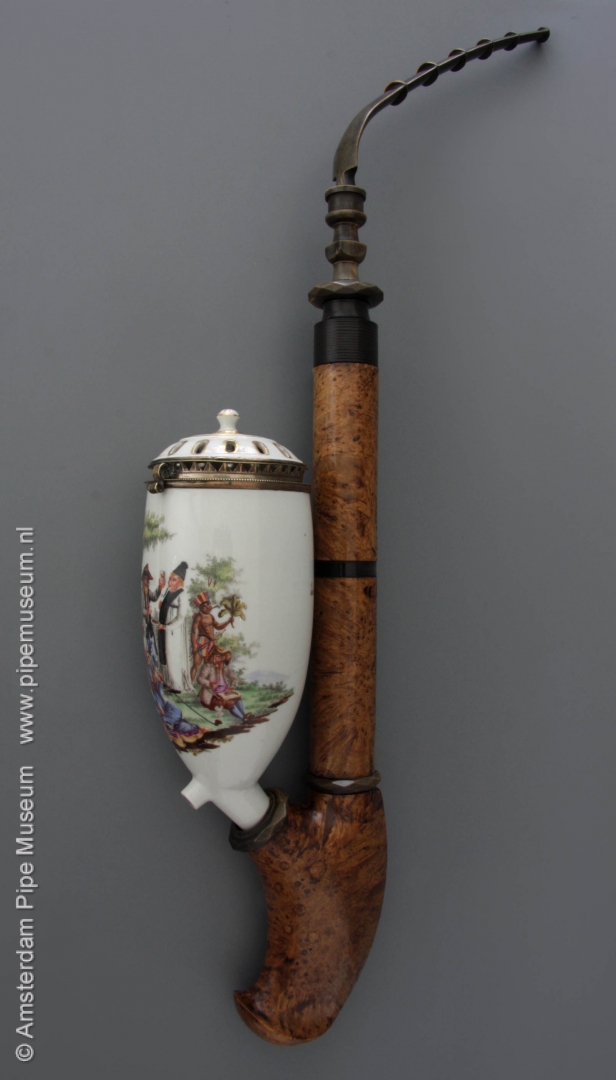

This cheerful scene is painted in a style that is characteristic for porcelain painting. The immaculate white of the porcelain plays a part in the image and ensures a fresh appearance of the article. For example, the trees and shrubs are indicated with a cloud of almost transparent green paint and the leaves are suggested by tufts of the brush of a harder or darker color. The figures themselves are depicted realistically, but in contrast to this full realism, the background is not colored in. That would make the image much heavier, while now, it contrasts more freshly with the white back ground.
A special feature of this show pipe is the mounting with a hinged cover consisting of a porcelain dome with a circle of rectangular cut slots for air supply in a silver-plated brass frame. A rare solution that will not return in the nineteenth century. On the heel, the object shows a gold leaf factory mark of a cloverleaf, the mark of the Limbach porcelain factory or the Ilmenau workshops. The date is around the year 1800. At the time it has been claimed that this pipe was presented to the monarch during a visit to the porcelain factory. A nice thought, but unfortunately without any proof.
Quite unexpected with the pipe bowl the original stem and other mounting was also preserved. It consists of a wooden moist reservoir and an upright wooden stem with a twisted buffalo horn mouthpiece including a long, flattened mouth piece with six knots. Assembled, this large-format pipe has an over-all length of over 75 centimeters. The open question with this pipe is how long you could smoke out of this pipe!
Amsterdam Pipe Museum APM 20.584
A quality pipe from Meissen
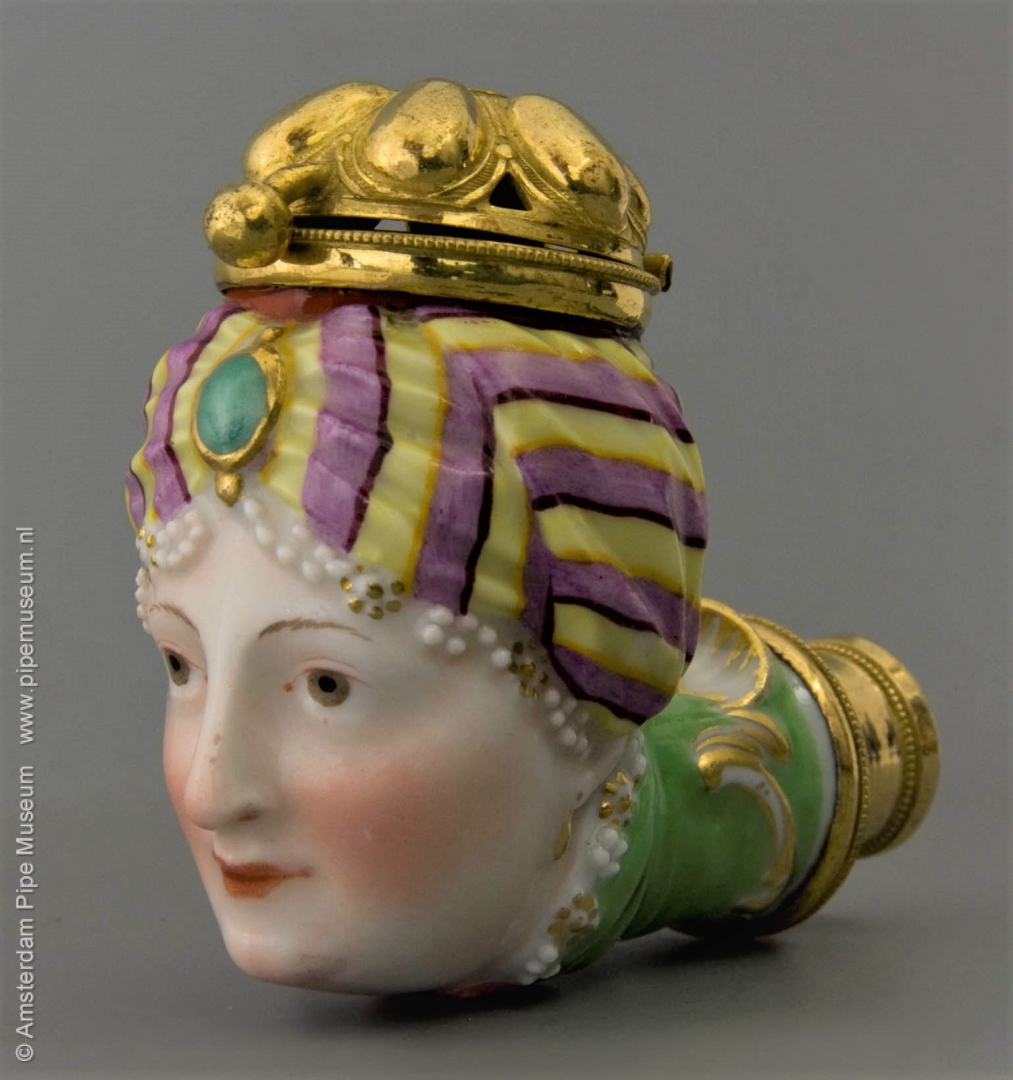
In the heyday of the Turkomania, everything from the Levant was popular, including in particular portraits of Turkish men and women with their fanciful turbans. This movement started as early as the 1740s and remained in vogue for almost a century at intervals, at least until 1820. All kinds of handicraft products depicted Turkish heads decked out in a colorful turban or related oriental headgear. These oriental headdresses were so beloved by the makers because they were easy to model realistically and very suitable for attractive painting. It comes at no surprise that a wide range of variations have been made over a long period of time.
This pipe bowl of a turbaned woman is discussed as the highlight of the porcelain production of Königlichen Sächsischen Porzellan-Manufaktur, the famous factory in Meissen. It is a brilliant and colorful example with a bright purple and yellow striped fabric turban as a striking element. Since the painters were asked to make the pipe bowls as varied as possible, the painting here runs opposite to the relief effect of the turban. This gives variation and extra liveliness to the turban. The fabric is embellished as usual with a large brooch – called aigrette or sarpech - with a green decorative stone at the front and a double cord of pearls along the edge. The woman's portrait itself shows earrings and a double pearl necklace around the neck, with a flat bow at the bottom as a closure. All details are not unique to this design, only the tasteful way of combining makes the design so beautiful.
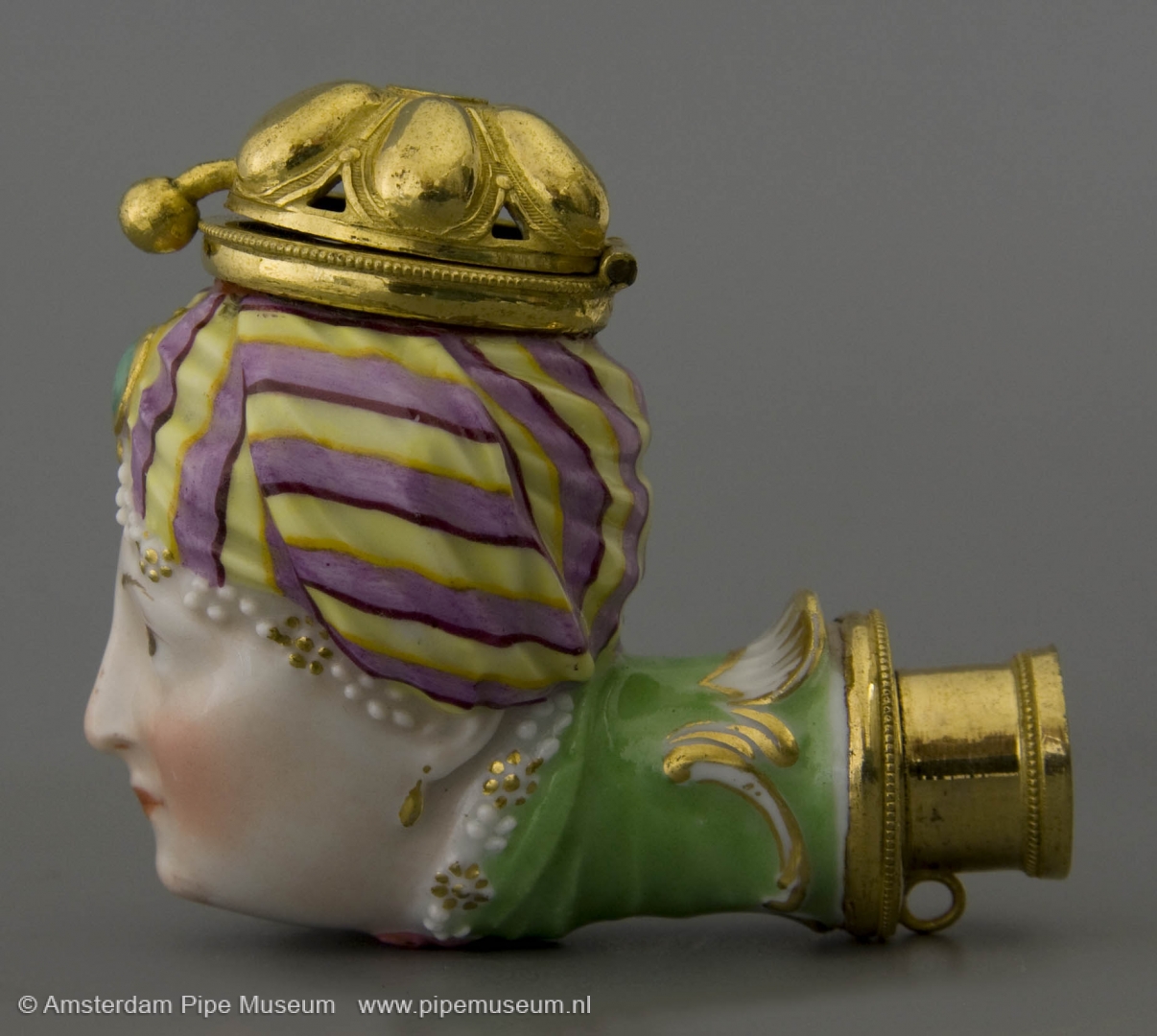
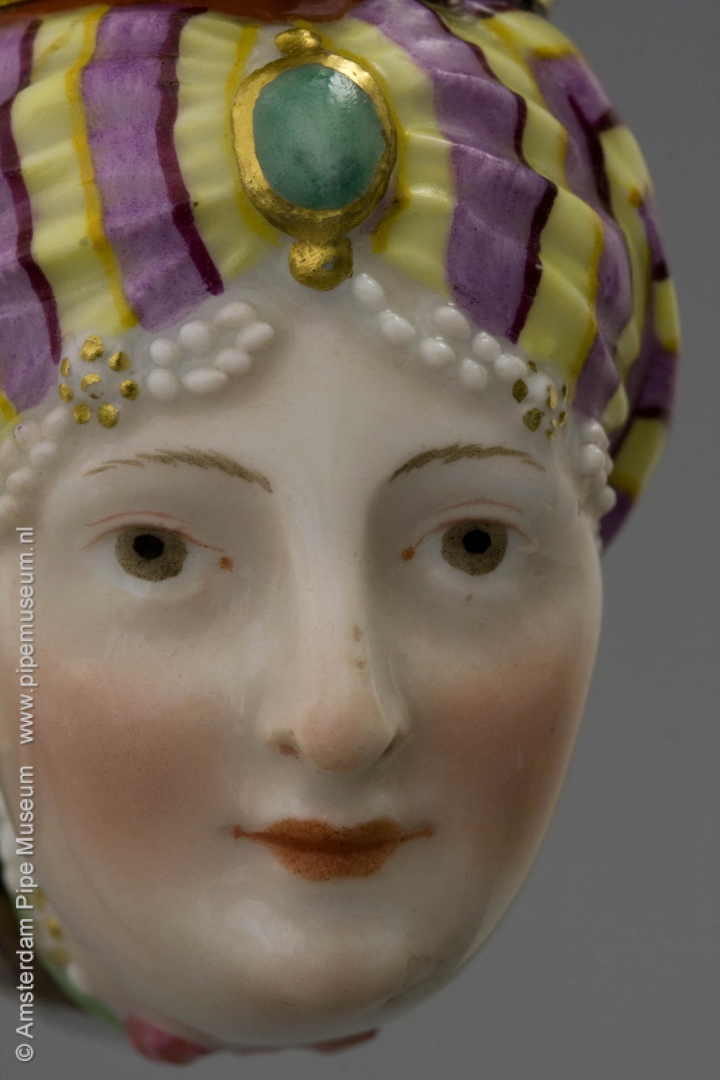
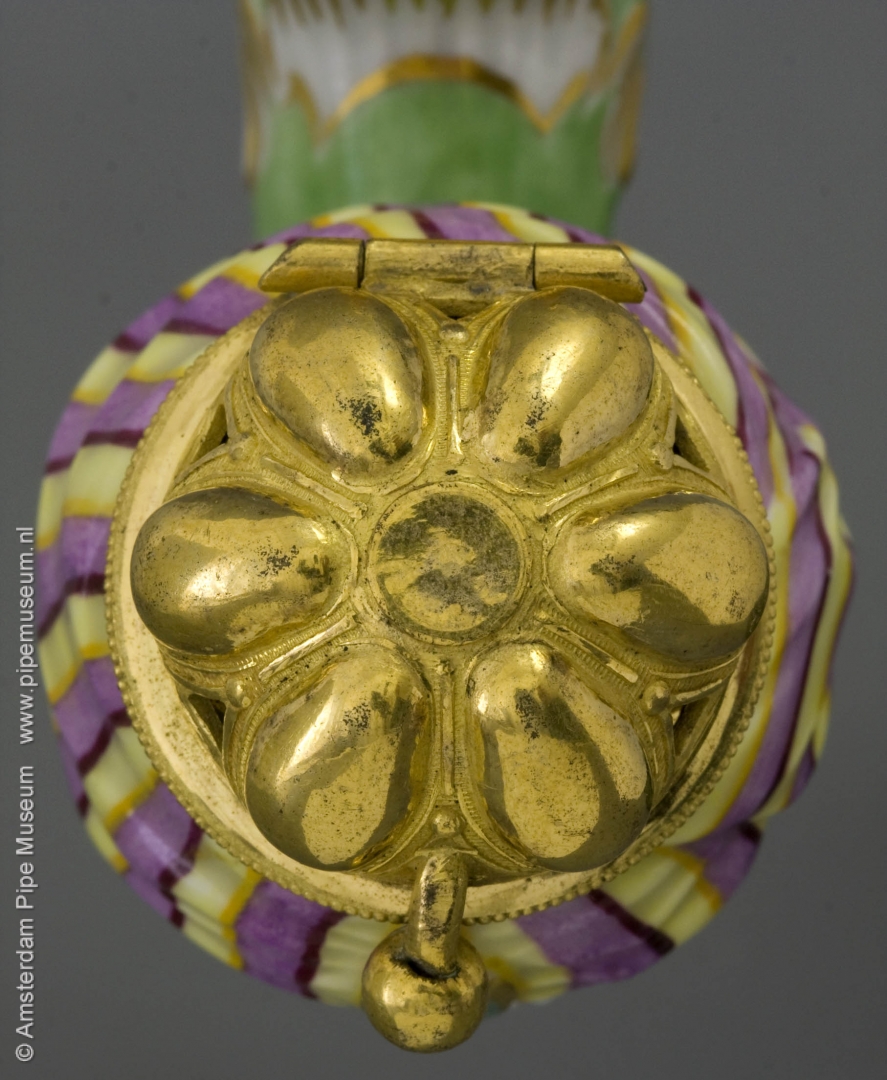
Not the pipe bowl, but the stem of the pipe betrays the period of its origin. It is precisely there, in the ornaments, the style characteristics are most explicitly shaped according to the fashion of the day. The short green stem ends in a graceful curl, a so-called c-volute on both sides and a shell motif on top and bottom. They are typical rococo elements with their movable asymmetrical shapes. The decoration is subtly brightened up with gold leaf. The original mounting of the pipe bowl shows a gold-plated brass hinged cover with six big lobes and a stem ring with locking eye. On the inside of the bowl we find the famous underglaze blue factory mark of the two crossed sabers.
We know from the archives of the porcelain factory that the design of this pipe bowl dates from 1742. Interestingly enough, unlike the ornamentation, this sophisticated pipe bowl does not date from the first hour. This is a later production and this is particularly evident on the inside of the pipe bowl, where the finish is smoother and more taut than in the beginning. The refined porcelain also indicates a later production, but certainly still eighteenth century. The painting with the subtle color nuance in the pink skin and finely brushed eyebrows is typically for that period. In bringing this pipe to the market at some later time, Meissen, being an established factory, has the advantage of drawing on past designs that can be reproduced without modification. That is an economic advantage. The object also shows that the product quality in Meissen is still optimal in later times and has even undergone further technical improvement.
Amsterdam Pipe Museum APM 16.071
Berlin stummel with Dutch landscape
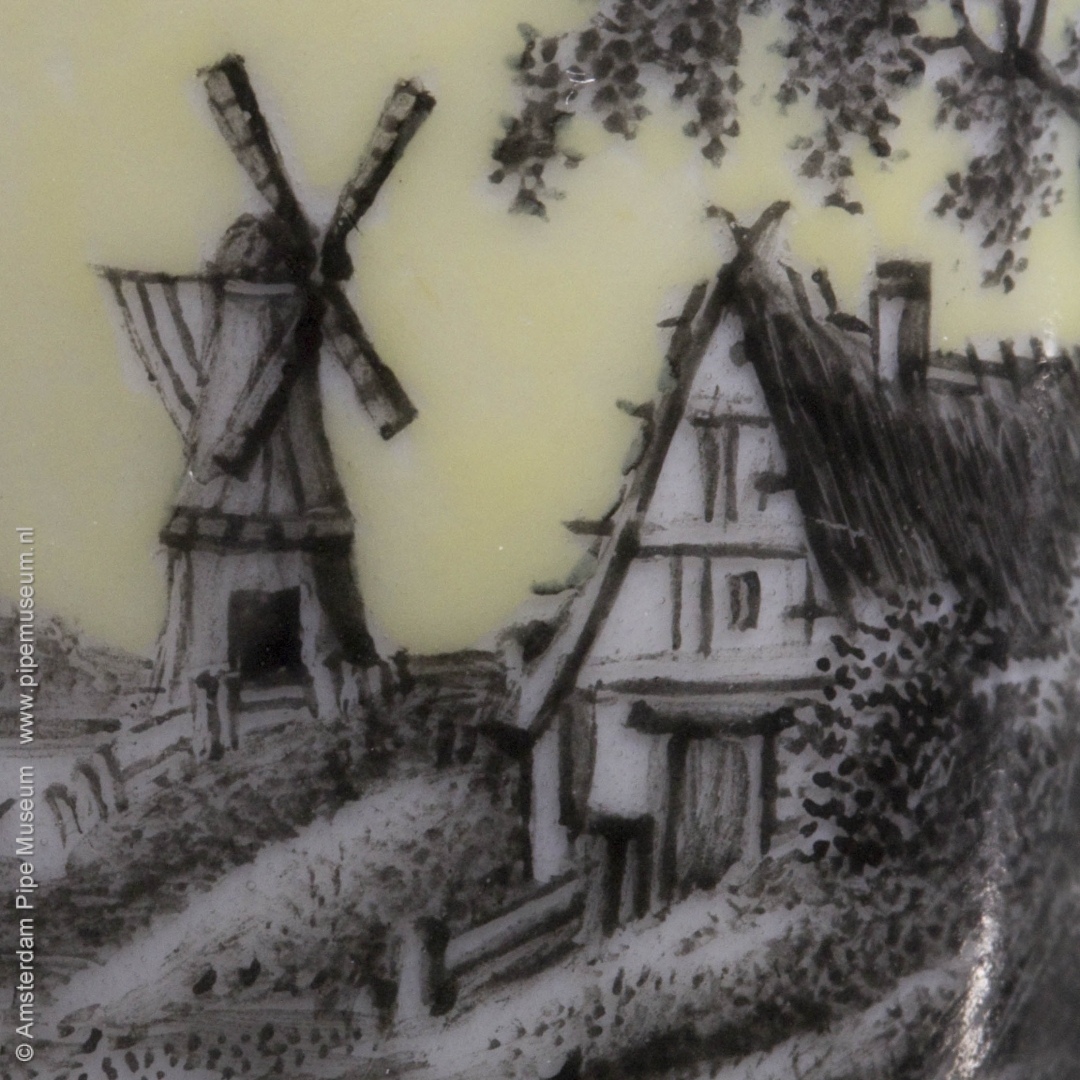
Towards the end of the eighteenth century, a new pipe shape was born in German porcelain factories. It is the Stummel, a model based on the Gouda clay tobacco pipe. The pipe bowl is oval in shape and equally well balanced as the Gouda example. To get a distinguished appearance, this pipe bowl is even slightly extended in height. At the transition from the bowl to the stem a heel is applied, while the stem is in the same angle as with the clay pipe, at least 120°. What makes the stummel so collectible is the meritorious painting. We see these qualities especially in the first period, after the Biedermeier time the product becomes a mass article in ever diminishing quality.
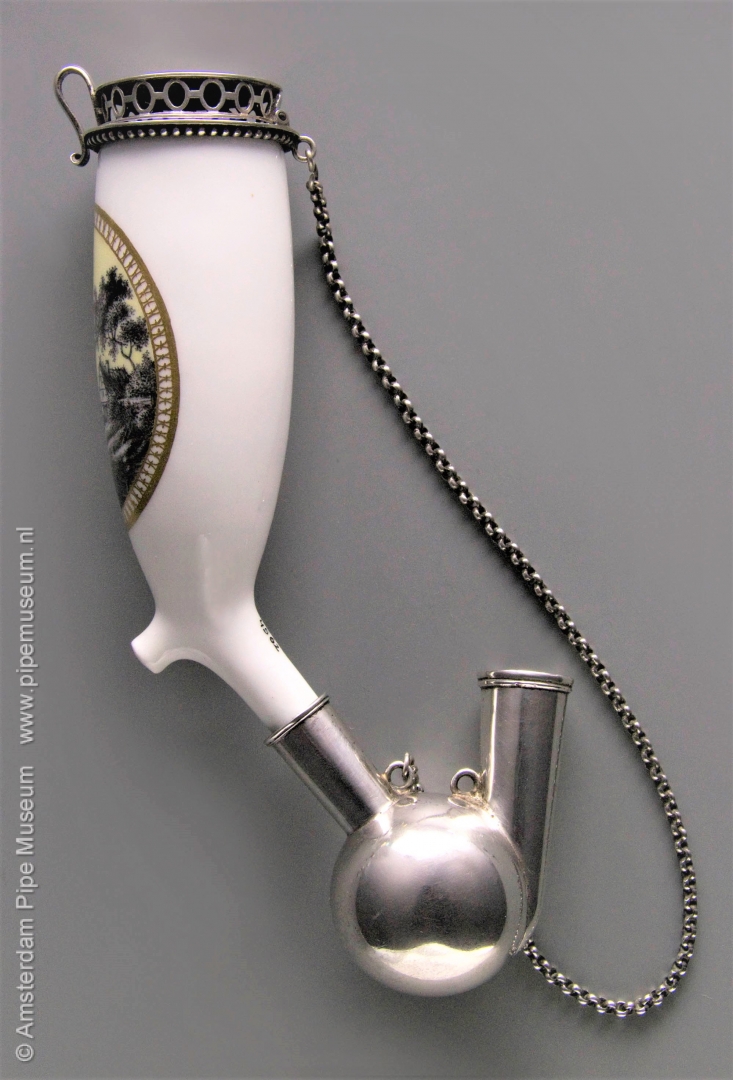

One of the highlights of porcelain painting shows this stummel from the Königliche Porzellan Manufaktur in Berlin. In addition to Meissen, the Berlin manufacturer enjoyed great prestige as well, being one of the leading porcelain factories in the world. Their great quality of the painting is clearly reflected in this pipe. The image on the front of the bowl falls within a standing oval framed by a double wide band of gold leaf that is artfully pierced and resembles an open-cut band. In this oval an extremely finely painted representation has been applied. This painting is not done in natural colours but in monochrome black, the so-called encre de chine, which testifies to a chic austerity. Pictured is a sloping landscape where a river flows through, right under a tree is a farm, in the back we see a high windmill. In the foreground are a few people at a boat. Despite the small size, the painting was done with the utmost care, it seems that the painter used a brush with only one hair. Quite unexpectedly, the clouds have been coloured with a plain, bright yellow background, a fashion colour for those days that is a bit unexpected for us now.
The date of this pipe is between 1810 and 1820. Production at the German porcelain factories was already highly standardized at that time. For example, one used a format number for the different sizes of stummels. This format number was often printed on the heel, in other cases on the stem. The figure "8" was the most common size, which we see very inconspicuously on the heel of this pipe bowl.
The luxurious painted pipe bowls were mounted with a silver rim with a hinged cover. With this pipe, the lid is more luxurious than average. Around the bowl a silver pearl fillet is applied just under the air inlet consisting of a sawn edge with upright ovals, as it were, following the oval picture frame. A so-called clamping spring serves as closure. The pipe bowl is complete with its original silver spherical moist bag with a retaining chain to the bowl. This bullet-shaped bag also indicates an early date. All in all, this pipe is a luxury example of a pipe bowl from a highly developed porcelain factory. The careful silver mounting underlines the special quality.
Amsterdam Pipe Museum APM 4.562
A regiment of Napoleonic soldiers
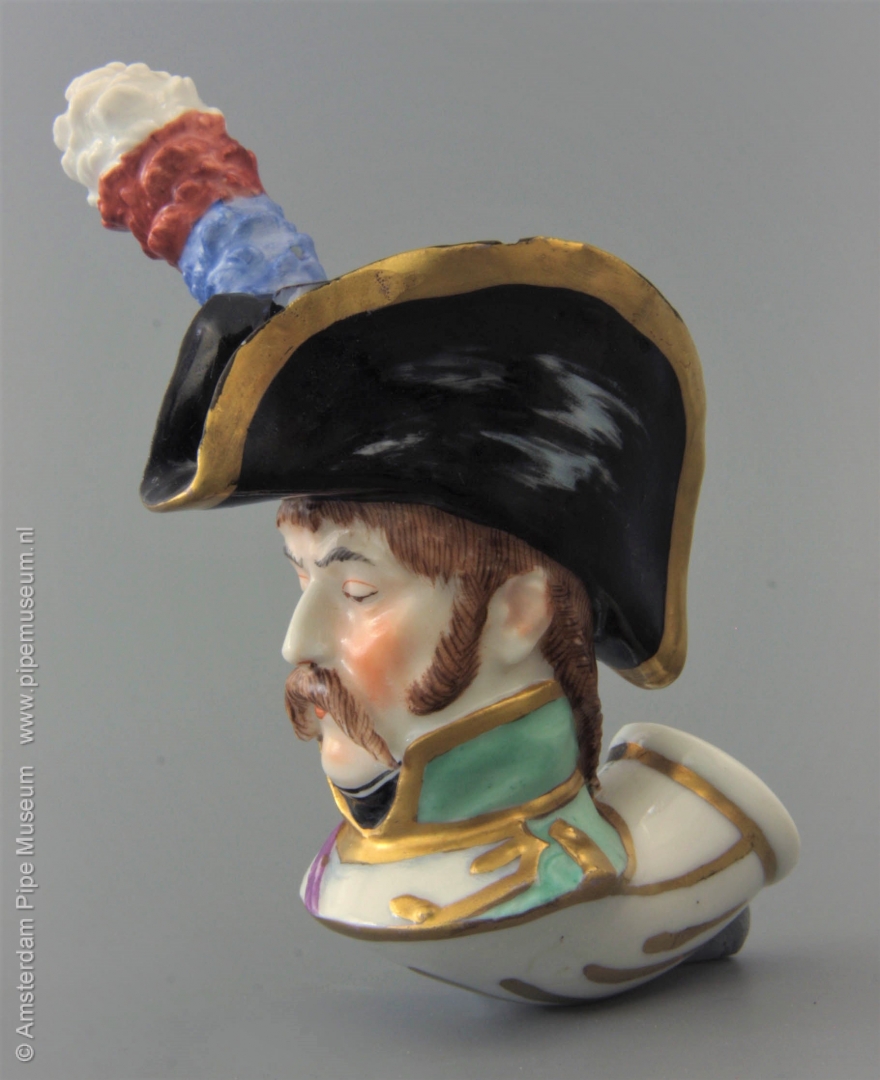
In the porcelain industry, there has always been great interest in figuration of the pipe. It was the authoritative German factories that had come up with unexpected porcelain designs in the eighteenth century, such as endearing pug-dogs turned into pipes. In the nineteenth century that fashion was partly taken over by the French. The porcelaine de Paris and the work of Jacob Petit might have made a special contribution to the figural pipe, although we do not know the full details of it yet. In addition, some series of figural pipes have been created, which also amaze us. An exclusive set of Napoleonic soldiers, for example, was produced by a yet unknown factory.
From this series, of which the Amsterdam Pipe Museum holds 22 specimen, one copy has been chosen for discussion here because it is a really exceptional example. It shows a general with a two-sided stitch on the head with a high feather plume in the colours white, red and blue. Everything about this pipe is over the top, that goes for the flamboyant modeling, the fine finish and the painting in bright colours. Finally, accents were still heightened with dust gold.
We can be certain that these pipes are modelled on existing costume prints depicting the different regiments of soldiers. The modeller studied meticulously the endless series of costumes and he completely faithfully reworked them, an assignment he took very seriously. This went so far as to include the portraits of the depicted men in harmony with their military status. We see faces ranging from iron-eaters and worn-out elderly fighters to immature persons under twenty years of age. The disadvantage of these portraits is that the lips are sometimes too feminine: the small red lips, together with the blushing is not really appropriate for a soldier.
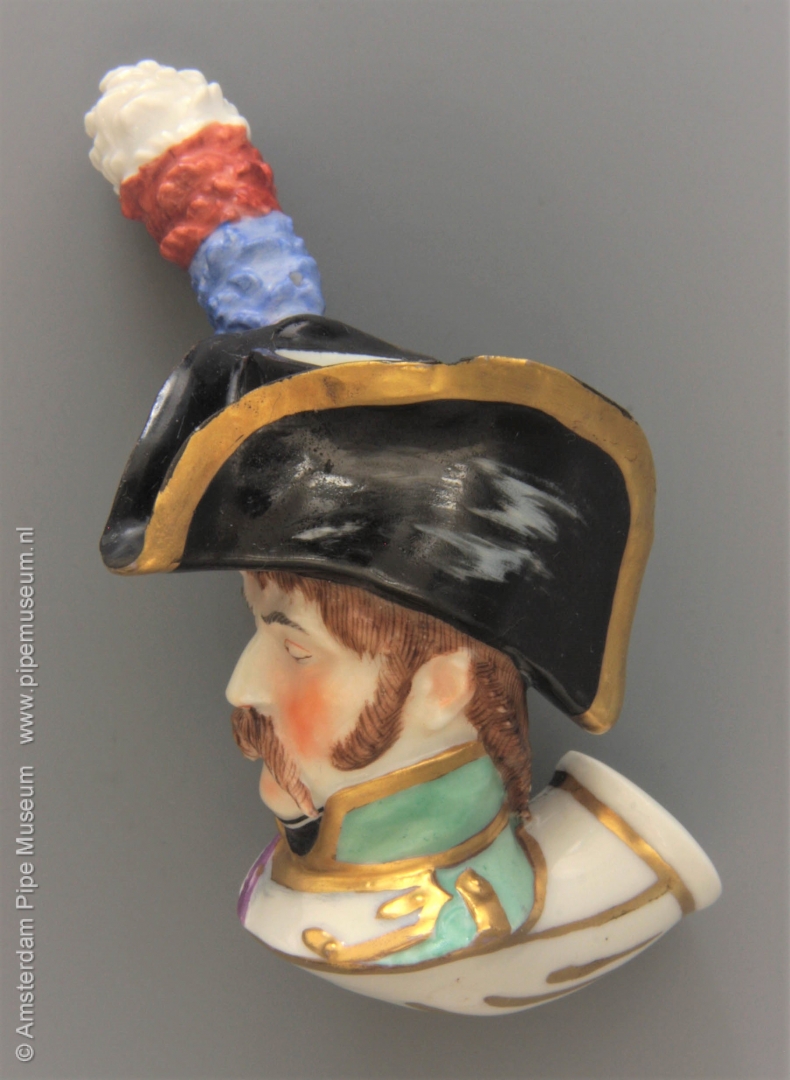
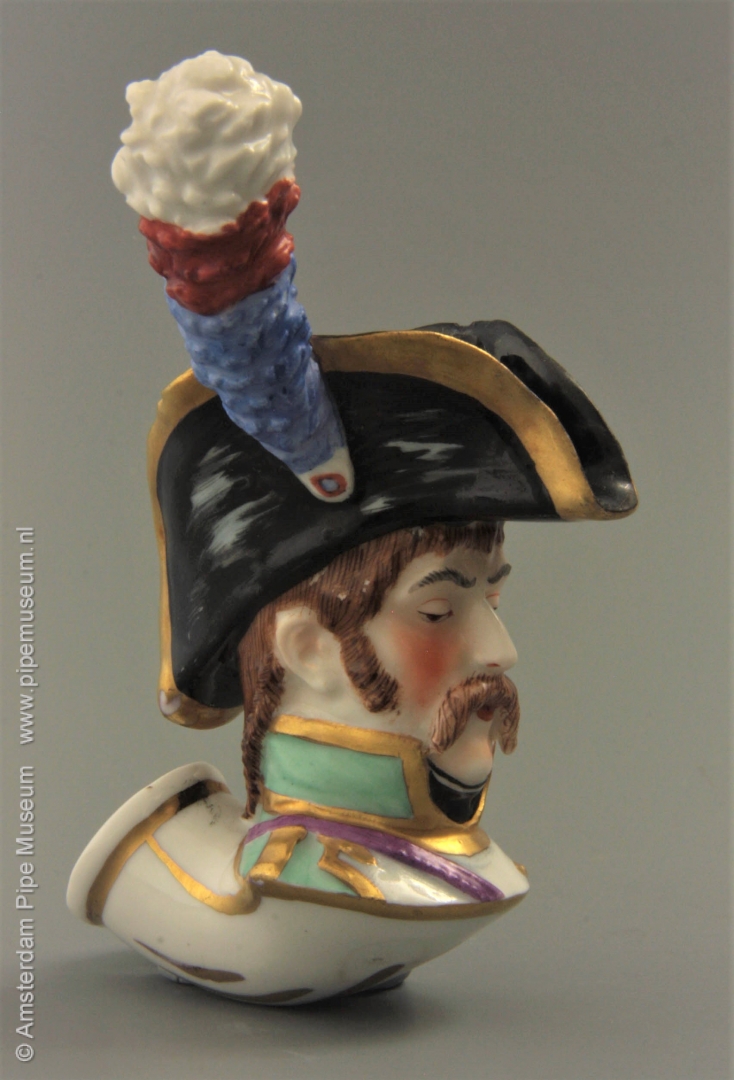
Except that the pipe bowls can be admired aesthetically, we can also appreciate their technical details. In that case, not the artistic merit comes first, but rather the functionality. Well, in terms of usability as pipe, the pipe bowls do not work perfectly. In the case of the general discussed here, for example, the feather plume far above the bowl opening is clearly inconvenient. During smoking, thumb or finger easily hang behind, while emptying the pipe is almost impossible. Because the interior of the bowl is strongly shaped to the outer design of the pipe, it resulted in a rather irregular shape. This is not really convenient for the smoker because inevitably tobacco remains behind in different places. Also the stub of some pipe bowls is not very pronounced so that it has a risk of breaking when the stem is inserted.
On the inside of the stub, these pipes show an incised shape number in Roman numerals. Those figures increase to far in the forty, so assumedly the complete series has consisted of dozens of different soldiers. This is more an early example of a collecting item than the need for the market to have new pipe models available. Did the manufacturer follow his hobby here? In any case, he ensured that his customers who could afford it would receive a special collectable that could be supplemented almost infinitely. We can assume that the series did not come about in one go, a new copy will be designed at regular intervals. Examination of the different specimens and especially the use of the gold also shows a certain periodization. For example, the gold leaf ornament on the underside of the bust is slightly more extensive at first, while the motif is sometimes even almost gone with later pipe bowls. As a matter of fact, this gold leaf was applied to obscure the prints of the baking support.
Amsterdam Pipe Museum APM 19.501